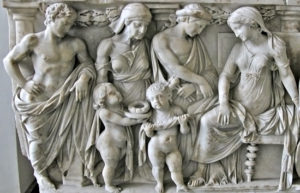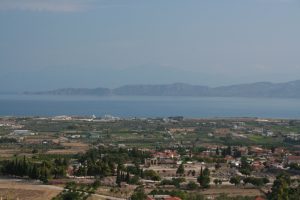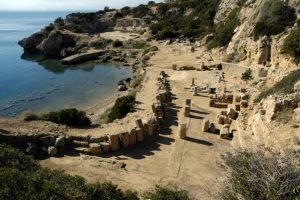[28] οἱ δὲ ἧκον εἰς Κόρινθον, καὶ δέκα μὲν ἔτη διετέλουν εὐτυχοῦντες, αὖθις δὲ τοῦ τῆς Κορίνθου βασιλέως Κρέοντος τὴν θυγατέρα Γλαύκην Ἰάσονι ἐγγυῶντος, παραπεμψάμενος Ἰάσων Μήδειαν ἐγάμει. ἡ δέ, οὕς τε ὤμοσεν Ἰάσων θεοὺς ἐπικαλεσαμένη καὶ τὴν Ἰάσονος ἀχαριστίαν μεμψαμένη πολλάκις, τῇ μὲν γαμουμένῃ πέπλον μεμαγμένον φαρμάκοις ἔπεμψεν, ὃν ἀμφιεσαμένη μετὰ τοῦ βοηθοῦντος πατρὸς πυρὶ λάβρῳ κατεφλέχθη, τοὺς δὲ παῖδας οὓς εἶχεν ἐξ Ἰάσονος, Μέρμερον καὶ Φέρητα, ἀπέκτεινε, καὶ λαβοῦσα παρὰ Ἡλίου ἅρμα πτηνῶν δρακόντων ἐπὶ τούτου φεύγουσα ἦλθεν εἰς Ἀθήνας. λέγεται δὲ καὶ ὅτι φεύγουσα τοὺς παῖδας ἔτι νηπίους ὄντας κατέλιπεν, ἱκέτας καθίσασα ἐπὶ τὸν βωμὸν τῆς Ἥρας τῆς ἀκραίας: Κορίνθιοι δὲ αὐτοὺς ἀναστήσαντες κατετραυμάτισαν.
- Map
- Pre Reading
- Post Reading
- Culture Essay
Although the saga of Jason and Medea begins in Colchis when Medea helps Jason recover the golden fleece, the story reaches a climax in Corinth when Jason decides to dismiss Medea and remarry the king’s daughter. How would you respond if you were a foreigner and a woman in a new land and divorced by your husband? This passage of the Library (1.9.28) offers a much-condensed version of the events recounted in Euripides’ well-known tragedy Medea, produced in 431 BCE, the same year that the Peloponnesian War began between Athens and Sparta.
N/A
Apollodorus of Athens was the last in the great tradition of scholars connected with the great Library of Alexandria, Egypt. Born around 180 BCE, he studied under the Stoic Diogenes, moved to Alexandria where he collaborated with Aristarchus, extended Eratosthenes’ Chronicles (Χρονικά) to his death in 120 or 110 BCE, wrote a commentary on Homer’s Catalogue of Ships (Περὶ τοῦ τῶν νεῶν καταλόγου) that offered a geographical account of the Homeric age, and authored an extensive account on Homeric religion called On the Gods (Περὶ θεῶν). In deference to his immense learning, a number of works were later attributed to Apollodorus, most famously the mythological handbook known as the Library (Βιβλιοθήκη). Organized around extended family relationships of the gods and heroes, the Library utilizes these genealogical links to clarify how the vast number of muthoi fit together in a coherent way and to connect various poleis through their divine and heroic family networks. The straightforward storytelling of the Library made it popular as a handbook to students learning Greek myths in antiquity, just as it does today. The last half of Book 3 breaks off after the first two Labors of Theseus and an Epitome provides a shorter account of the last four labors.
The Bibliotheca is an example of a larger genre known as mythography, the collection and organization of mythical stories, often geographically or chronologically. By definition, mythography encompasses a wide range of material, beginning with the Homeric Catalogue of Ships and Hesiod’s Theogony. Mythography is often organized through the use of catalogues, genealogies, theogonies, cosmogonies, and chronological “cycles.” The earliest examples of mythography can be found in the scholia (notes on canonical texts by ancient scholars), the hypotheses (summaries) of tragic drama, or as digressions in geographical or astronomical works, but by the first century BCE, the most common form becomes manuals or handbooks for the reading public, such as the Library. The Library is organized both chronologically and genealogically, beginning with the creation of the cosmos and then by various family trees.


